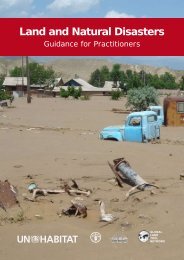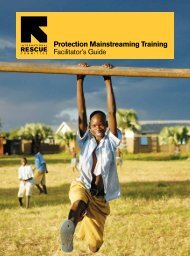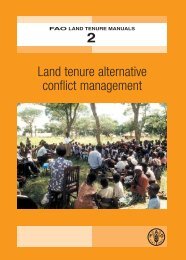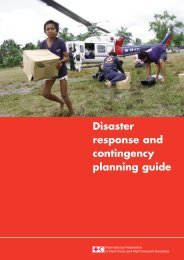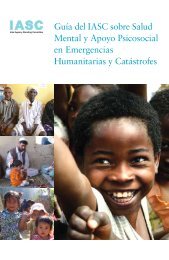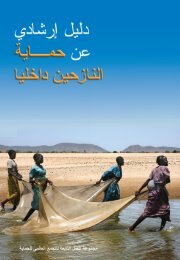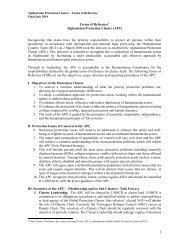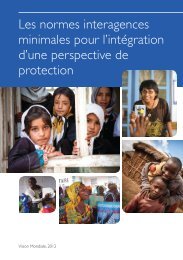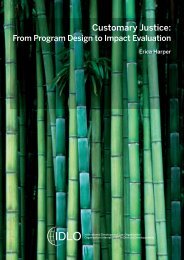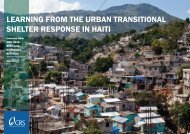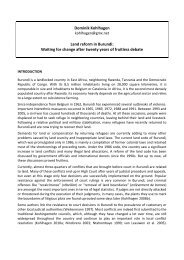Inter-Agency Real Time Evaluation of the Response to Cyclone Nargis
Inter-Agency Real Time Evaluation of the Response to Cyclone Nargis
Inter-Agency Real Time Evaluation of the Response to Cyclone Nargis
Create successful ePaper yourself
Turn your PDF publications into a flip-book with our unique Google optimized e-Paper software.
virtually all communities in <strong>the</strong> worst-affected areas was that <strong>the</strong>y “have nothing <strong>to</strong> do” and a desirefor livelihood support in <strong>the</strong> form <strong>of</strong> agriculture or fishing inputs, or capital <strong>to</strong> (re)start businesses.<strong>Time</strong> constraints precluded detailed investigations in<strong>to</strong> <strong>the</strong> CERF or Flash Appeal. From <strong>the</strong> handful<strong>of</strong> interviews with UN and INGO staff where <strong>the</strong>se issues were raised it was clear that more remains<strong>to</strong> be done in improving transparency and consultation and in educating NGOs regarding CERF andFlash Appeal processes and objectives. For example, <strong>the</strong>re was still confusion amongst some seniorINGO staff about <strong>the</strong> difference between <strong>the</strong> CERF and a Flash Appeal.3.3.1 Funding RecommendationR.3. Donors should make available adequate funding for livelihood activities for <strong>the</strong> response <strong>to</strong><strong>Cyclone</strong> <strong>Nargis</strong> and for appropriate international components <strong>of</strong> a national DRR strategy.3.4 ClustersBased on interviews and document review, clusters in Yangon were seen as useful in settingdirection, mobilizing resources and, particularly in <strong>the</strong> case <strong>of</strong> national staff, perceived as a usefulcapacity building forum. “Predictability” played out in various ways. A pre-existing in-countryIASC established <strong>the</strong> previous year helped ensure that clusters were established in Yangon almostimmediately after <strong>the</strong> cyclone hit. UNHCR played a useful interim role in leading <strong>the</strong> shelter clusteruntil IFRC assumed leadership once <strong>the</strong>y were able <strong>to</strong> deploy <strong>the</strong> necessary staff.Ano<strong>the</strong>r favorable comparison with <strong>the</strong> tsunami response is that national agencies are relativelywell-represented at all cluster meetings, particularly at hub level, and most <strong>of</strong> <strong>the</strong> staff interviewed(including from <strong>the</strong> private sec<strong>to</strong>r) found <strong>the</strong>m very useful learning opportunities.Key informants were asked <strong>to</strong> rate clusters and describe <strong>the</strong> features that <strong>the</strong>y felt contributed <strong>to</strong> aneffective cluster. The health cluster was ranked highest by virtually all respondents, and <strong>the</strong> positivefeatures <strong>the</strong>y mentioned included:Strategic level <strong>of</strong> discussion (i.e. not limited <strong>to</strong> information sharing);Government participation;Development <strong>of</strong> useful technical <strong>to</strong>ols and guidelines;Effective meeting management, including efforts <strong>to</strong> engage local ac<strong>to</strong>rs; andCo-chairing by UN and NGO. Co-chair arrangement was perceived <strong>to</strong> limit potentialconflict <strong>of</strong> interest, reduce problems related <strong>to</strong> frequent cluster lead turnover and <strong>the</strong>shared workload afforded cluster leads <strong>the</strong> possibility <strong>of</strong> spending more time in <strong>the</strong> field.There was widespread acknowledgement amongst both national and international key informants <strong>of</strong>weak linkages between Yangon clusters with hubs and national ac<strong>to</strong>rs. Many staff in <strong>the</strong> hubs wereonly partially aware <strong>of</strong> <strong>the</strong> planning processes going on at Yangon level. This was viewed by <strong>the</strong> IARTE team as a contribu<strong>to</strong>ry fac<strong>to</strong>r in limiting information flows <strong>to</strong> communities. Ano<strong>the</strong>r example<strong>of</strong> <strong>the</strong> weak linkage was a geographic prioritization on more populated areas leaving some <strong>of</strong> <strong>the</strong>worst affected areas underserved (described in section 6.1 above).Most cluster meetings in Yangon are conducted in English with no translation services available,which some interviewees from national organisations claimed made <strong>the</strong>m feel “unwelcome”. Thesituation was observed <strong>to</strong> be much better at hub level since verbal translation services are available.Meetings observed by IA RTE members were all conducted in English, and translated from19



